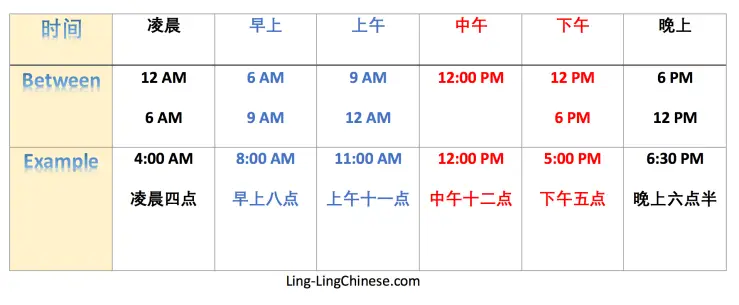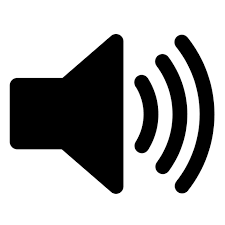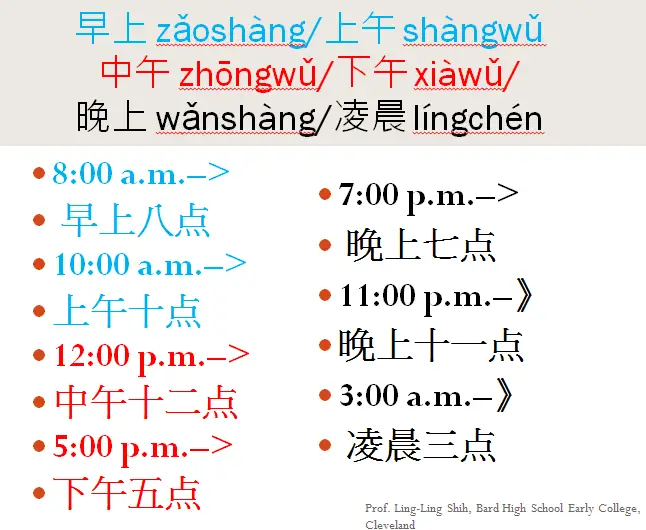By Ling-Ling Lisa Shih
From Ling-LingChinese.com
In this lesson we will learn how to use the following time words to talk about different times of the day.


Download the above table: AM and PM in Chinese in TABLE (in Word document)
**All the vocabulary mentioned in this Lesson is included toward the end of this post.**
Here is a good lesson to learn before reading this post: What time is it now? 现在几点了?)
Also you will need to review numbers in Chinese in order to talk about time and dates. Once you learn 1 to 10, It is very easy to learn how to count to 100! Here are posts on counting Numbers in Chinese:
How a language expresses time differs from culture to culture. Chinese expresses dates and time from the larger unit to the smaller unit.
Date in Chinese:
When we talk about the date, for example, Nov. 2, 2018, Chinese would say Year first, Month, and then date:
Say date in Chinese
Date:Year Month Day
日期:____ 年 ____ 月 ____ 日
(e.g., 二〇一八年十二月二十五日)
For example,
November 5, 2018
èr líng yì bānián shíyīyuè wǔrì
二 零 一 八 年 十一 月 五 日 (pronounce the year one digit at a time)
In spoken language, you can say:
èr líng yì bānián shíyīyuè wǔhào
二 零 一 八 年 十一 月 五 号 (Replace “日” with“号” for the spoken language.)
Time (时间): A.M. and P.M. in Chinese
To talk about time, Chinese also use the same order: The larger unit/more general goes first too, the smaller/more specific goes last.
Say AM in in Chinese
AM + N O’clock + N Min.
–> 凌晨/早上/上午 + N 点 + N 分
Say PM in in Chinese
PM+ N O’clock +N Min.
—>中午/下午/晚上 + N 点 + N 分
Note that in English, you say AM or PM last, but in Chinese, we say it first. Also note that Chinese use more time expressions to indicate A.M. and P.M. We use different Chinese time expressions to indicate whether it is in the earlier/later morning, at noon, in the afternoon, or at night. In English, you only use “a.m.” to talk about the first 12 hours of the day (more specifically, 12:00 am-11:59:59 a.m.) and use “p.m.” to cover the other half of the day (more specifically, 12:00 p.m. to 11:59:59 p.m.).
Add the following Chinese time expressions to indicate a.m. and p.m. :
Chinese Time Expressions for A.M. and P.M.
早上 zǎoshàng:(earlier) morning
上午 shàngwǔ: morning; a.m. (referring to later hours in the morning between 9 a.m. and 12 p.m.)
中午 zhōngwǔ: noon
下午 xiàwǔ: Afternoon (after 12 p.m. and before 6 p.m.)
晚上 wǎnshàng: night; p.m. (between 6 p.m. and 12 p.m.)
凌晨 língchén:early in the morning (between 12 a.m. and 6 a.m.)
ling-lingchinese.com
Say A.M. in Chinese:
Say AM in in Chinese
AM + N O’clock + N Min.
凌晨/早上/上午 + N 点 + N 分.
For “a.m.”, 早上 (zǎoshang: morning) is used to indicate earlier hours (between 6 and 9) in the morning and 上午 (shàngwǔ: morning) is used to indicate hours between 9:00 a.m. and 12:00 a.m. “凌晨” (língchén) is used to talk about very early hours in the morning. For example, 1-5 a.m., 凌晨一点,两点,三点,四点,五点.
Say PM in Chinese
Say PM in Chinese
PM+ N O’clock +N Min.
中午/下午/晚上 + N 点 +N 分
For “pm,” it could also be expressed differently depending on whether it is referring to the time in the afternoon or time in the evening. For the time between 12 pm and 6 p.m., we use “下午” (xiàwǔ: literally “afternoon”) in Chinese. For instance, 3:00 p.m., in Chinese, we say “下午三点”. For the time between 6 p.m. to 12 p.m., we use the word “晚上” (wǎnshàng: literally meaning “evening”). For instance, 7:00 pm, we say “晚上七点” in Chinese.
Let’s use the Time expressions table again to practice how to indicate A.M. and P.M. in Chinese.
Vocabulary Used in This Lesson:
To see and hear the sentence examples for these vocabularies, please click on the vocabulary.
| ID | Chinese | Trad. | Pinyin | English Definition | ||
|---|---|---|---|---|---|---|
| ID | Chinese | Trad. | Pinyin | English Definition | ||
| 1 | 日期 | 日期 | rì qī | date; Classifiers: 个 | ||
| 2 | 年 | 年 | nián | year | ||
| 3 | 月 | 月 | yuè | moon; month; monthly; Classifiers: 个 | ||
| 4 | 日 | 日 | rì | sun; day; date, day of the month | ||
| 5 | 号 | 号 | hào | day of a month | ||
| 6 | 时间 | 时间 | shí jiān | time; Classifiers: 段 | ||
| 7 | 点 | 点 | diǎn | point; o’clock | ||
| 8 | 分 | 分 | fēn | minute (unit of time) | ||
| 9 | 秒 | 秒 | miǎo | second (unit of time) | ||
| 10 | 凌晨 | 凌晨 | língchén | very early in the morning; in the wee hours | ||
| 11 | 早上 | 早上 | zǎoshang | early morning; Classifiers: 个 | ||
| 12 | 中午 | 中午 | zhōngwǔ | noon; midday; Classifiers: 个 | ||
| 13 | 下午 | 下午 | xià wǔ | afternoon; Classifiers: 个 ; p.m. | ||
| 14 | 晚上 | 晚上 | wǎnshang | evening; night; Classifiers: 个 ; in the evening | ||
| 15 | 半夜 | 半夜 | bàn yè | midnight; in the middle of the night |
日期 年 月 日 号 时间 点 分 秒 凌晨 早上 中午 下午 晚上
半夜
To hear them pronounced in a sequence, copy above vocabularies and paste here: Talking “Chinese to Pinyin/Zhuyin Converter”

More resources:
- Am or Pm? Tell Time In Chinese | Time Words In Chinese
- YouTube videos teaching the usages of these time expressions for a.m. and p.m.:

